
Euphorbia dentata (Green Poinsettia, Toothed Spurge, Etc.) on 9-24-21, #835-19.
Green Poinsettia, Toothed Spurge, Toothedleaf Poinsettia, Eastern Toothed Spurge
Euphorbia dentata
yoo-FOR-bee-uh den-TAY-tuh
Synonyms of Euphorbia dentata (8) (Updated on 12-17-23 from Plants of the World Online): Anisophyllum dentatum (Michx.) Haw., Euphorbia aureocincta Croizat, Euphorbia dentata var. linearis Engelm. ex Boiss., Euphorbia dentata var. rigida Engelm., Euphorbia fontanesii Steud., Euphorbia herronii Riddell, Euphorbia purpureomaculata T.J.Feng & J.X.Huang, Poinsettia dentata (Michx.) Klotzsch & Garcke
Euphorbia dentata Michx. is the accepted scientific name for this species of Euphorbia. It was named and described as such by André Michaux in Flora Boreali-Americana in 1803.
The genus, Euphorbia L., was named and described by Carl von Linnaeus in the first volume of the first edition of Species Plantarum in 1753.
As of 12-17-23 when this page was last updated, Plants of the World Online lists 2,040 species in the Euphorbia genus. It is a member of the plant family Euphorbiaceae with a total of 228 genera. Those numbers could change as updates are made on POWO. The number of species in the genus fluctuates often.

Distribution map of Euphorbia dentata from Plants of the World Online. Facilitated by the Royal Botanic Gardens, Kew. Published on the Internet; http://www.plantsoftheworldonline.org/. Retrieved on November 21, 2021.
The above distribution map for Euphorbia dentata is from Plants of the World Online. Areas in green are where the species is native and purple is where it has been introduced. The map on the USDA Plants Database for North America is a little different and the BONAP map is more in line with POWO…
The map on iNaturalist shows where members have made observations. Anyone can join and it is a great website to confirm and share your observations. The maps on iNaturalist are continually updated as members post new observations.
THERE ARE SEVERAL LINKS AT THE BOTTOM OF THE PAGE FOR FURTHER READING AND TO HELP WITH A BETTER POSITIVE ID.
Photos taken in 2022 are at the bottom of the page under the links…
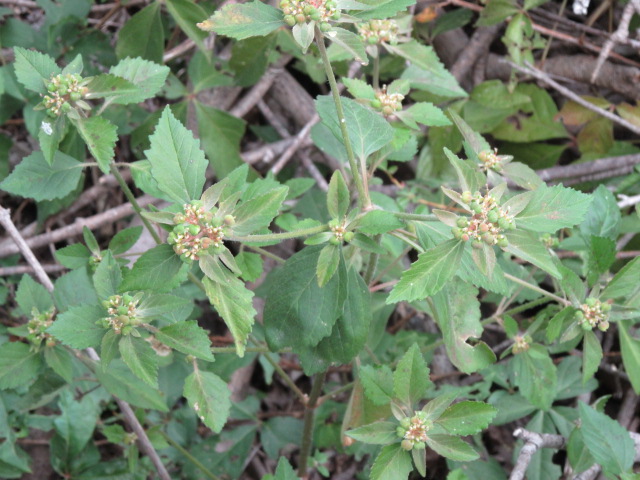
Euphorbia dentata (Green Poinsettia, Toothed Spurge, Etc.) on 9-24-21, #835-20.
You never know where an interesting wildflower is going to show up. There are 40 acres here on the farm and where did this one pop up? In the basement of the old foundation where my grandparent’s house used to be. I have never seen it anywhere else here and it always makes me wonder how it even got where it was in the first place… I didn’t climb down in the basement with it. I just zoomed in the best I could and took A LOT of photos then selected a few that came out well.
Euphorbia dentata is an annual wildflower that grows throughout Missouri and much of central United States eastward (plus California) where it is either native or has been introduced. The map on POWO also indicates the species is a native of Northeast Mexico and has been introduced in Ontario in Canada and north-central China.
Information states this species likes full sun in just about any soil, although it supposedly prefers poor soil with plenty of clay, sand, or gravel. Where I found it was close to the corner in the basement of the old foundation where it likely didn’t get full sun. It was growing on top of old boards and the only soil it had was from decaying plant matter. It still baffles me how its seeds got down there anyway and germinated… Otherwise, it can be found along streambanks, forests, glades, upland prairies, fields, pastures, gardens, and so on…
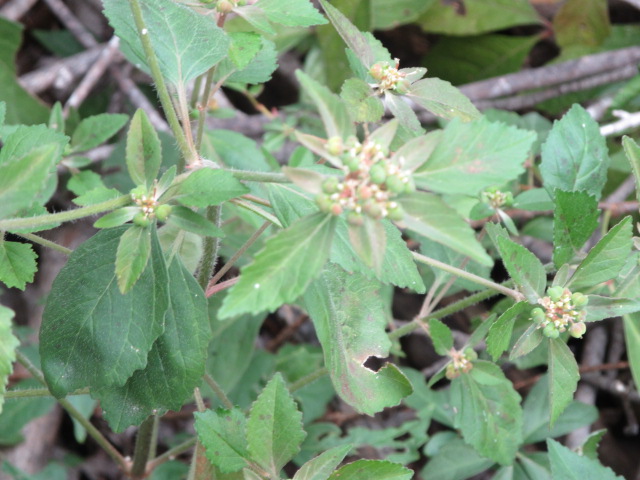
Euphorbia dentata (Green Poinsettia, Tooth Spurged, Etc.) on 9-24-21, #835-21.
Euphorbia dentata grows up to 2’ tall in favorable conditions and grows from multiple stems from the base and branches out somewhat. Stems are green, yellowish-green, sometimes reddish-green. The stems are densely pubescent with short downward-facing hairs. It can also have scattered longer multicellular hairs.
The leaves of Euphorbia dentata are highly variable. For the most part, they grow in an opposite manner along the stems but can be alternate. They can be linear, lance-shaped (lanceolate), to nearly circular in outline, 3/4-3” long x 1/4-1” wide, tapered at the base with petioles, bluntly pointed at the tip. Leaf margins can be coarsely or finely toothed and even fairly smooth, scalloped, or wavy. The surfaces of the leaves are sparsely to densely hairy (pubescent). They can be green, grayish-green, and can be reddish to purplish-tinged. Leaf undersides are paler than the upper surface.
The flowers are somewhat hard to explain. The stems of the plant are topped with 1-3 clusters of cyathia each with 25-40 staminate flowers and immature fruits.
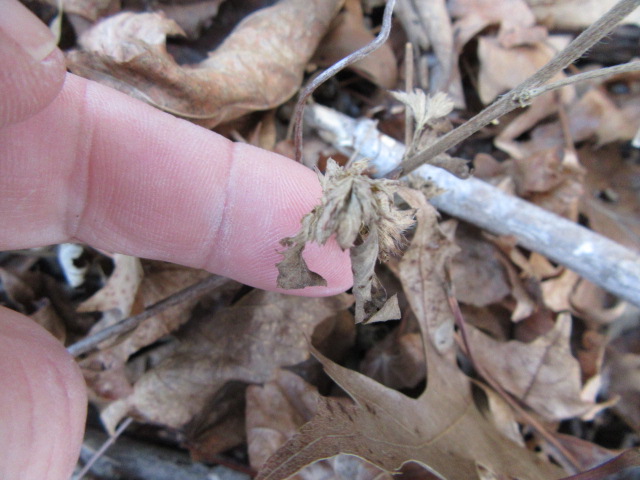
Euphorbia dentata (Toothed Spurge) on 1-24-22, #860-1.
I was writing a post about “I should have” and what if” using the Euphorbia dentata as an example. I “should have” went ahead and climbed down into the basement to get better photos in September 2021 when I first found this species. Then I got to thinking “what if” seeds don’t come up in 2022. After all, I found this plant in the basement of my grandparent’s old home where there is not much but old boards and brush. The odds weren’t very good. So, I got up, grabbed the camera, then went to the garage and got the ladder. I put the ladder close to where I found the Euphorbia dentata, and a little to the left and I would have been on top of it…
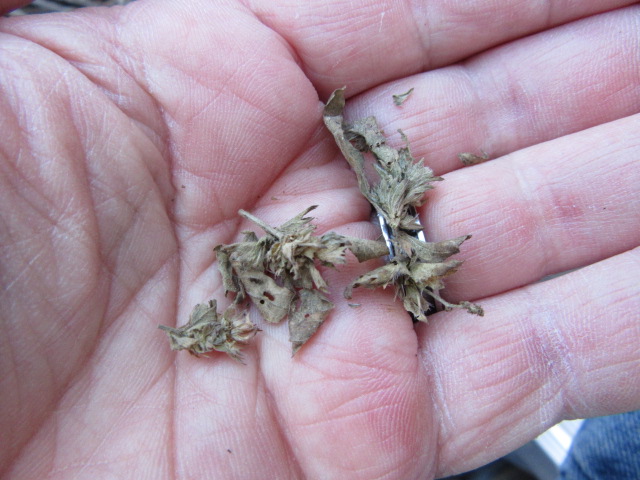
Euphorbia dentata (Toothed Spurge) on 1-24-22, #860-2.
I pulled off several of the dried-up flowers but still left more than I took.
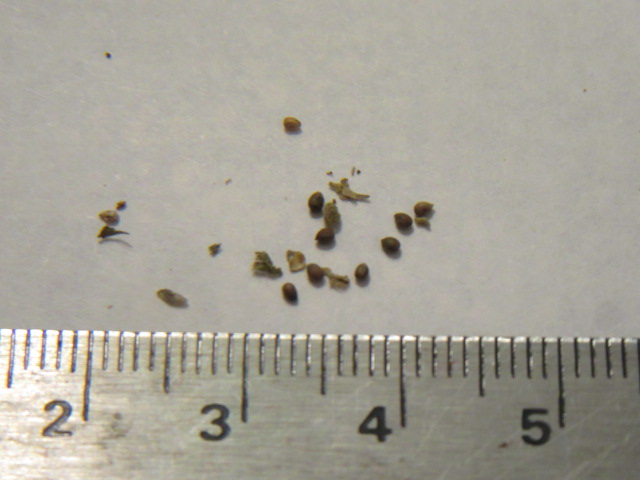
Euphorbia dentata (Toothed Spurge) on 1-24-22, #860-3.
Once I brought my find to the house, I crumbled up everything and started looking for seed. Sorry the photo is a little blurry, but those seeds are only 2-3 mm long… The ruler is on the metric side. Now that I had a few seeds, I will see if I can get them to come up in the spring in a better place than in the old foundation.
PHOTOS FROM 2022 AT THE BOTTOM OF THE PAGE…
I found Euphorbia dentata in several places in 2022 and took A LOT of photos… I found a colony by the mailbox, in front of the old foundation, under a Chinese Elm tree, and along the Rock Island Spur of the Katy Trail. I also found a large colony of what I thought was Euphorbia davidii (David’s Spurge) at the city park next to the farm (no page yet).
So what happened to the seeds I collected? Well, I didn’t plant them… The summer of 2023 was very hot and dry and I didn’t find a single Euphorbia dentata anywhere…
I have enjoyed photographing and learning about the many wildflowers growing on the family farm and other areas. The farm is in Windsor, Missouri in Pettis County (Henry County is across the street and Benton and Johnson aren’t far away). I have grown over 500 different plants and identified over 250 species of wildflowers (most have pages listed on the right side of the page). I am not an expert, botanist, or horticulturalist. I just like growing, photographing, and writing about my experience. I rely on several websites for ID and a few horticulturalists I contact if I cannot figure them out. Wildflowers can be somewhat variable from location to location, so sometimes it gets a bit confusing. If you see I have made an error, please let me know so I can correct what I have written.
I hope you found this page useful and be sure to check the links below for more information. They were written by experts and provide much more information. Some sites may not be up-to-date but they are always a work in progress. If you can, I would appreciate it if you would click on the “Like” below and leave a comment. It helps us bloggers stay motivated. You can also send an email to me at thebelmontrooster@yahoo.com. I would enjoy hearing from you especially if you notice something is a bit whacky.
FOR FURTHER READING:
PLANTS OF THE WORLD ONLINE (GENUS/SPECIES)
INTERNATIONAL PLANT NAMES INDEX (GENUS/SPECIES)
TROPICOS (GENUS/SPECIES)
FLORA OF NORTH AMERICA (GENUS/SPECIES)
WORLD FLORA ONLINE (GENUS/SPECIES)
WIKIPEDIA (GENUS/SPECIES)
USDA PLANTS DATABASE
DAVE’S GARDEN
MISSOURI PLANTS
UNIVERSITY OF MISSOURI
iNATURALIST
WILDFLOWER SEARCH
ARKANSAS NATIVE PLANT SOCIETY
ILLINOIS WILDFLOWERS
MINNESOTA WILDFLOWERS
KANSAS WILDFLOWERS AND GRASSES
GO BOTANY
LADY BIRD JOHNSON WILDFLOWER CENTER
MARYLAND BIODIVERSITY PROJECT
BACKYARD NATURE
VIRGINIA TECH
NOTE: The data (figures, maps, accepted names, etc.) may not match on these websites. It depends on when and how they make updates and when their sources make updates. Some websites have hundreds and even many thousands of species to keep up with. Accepted scientific names change periodically and it can be hard to keep with as well. Some of the links may use a name that is a synonym on other sites. In my opinion, Plants of the World Online by Kew is one of the most reliable and up-to-date plant databases and they make updates regularly. I make updates “at least” once a year and when I write new pages or add new photos but I do get behind. We are all a work in progress. 🙂
PHOTOS FROM 2022…

Euphorbia dentata (Green Poinsettia, Toothed Spurge, Etc.) on 7-17-22, #899-7.
The above photo and the next three were taken of plants along the Rock Island Spur of the Katy Trail. The trail runs along the farm and the city park is on the other side of the trail.

Euphorbia dentata (Green Poinsettia, Toothed Spurge, Etc.) on 7-17-22, #899-8.

Euphorbia dentata (Green Poinsettia, Toothed Spurge, Etc.) on 7-17-22, #899-9.

Euphorbia dentata (Green Poinsettia, Toothed Spurge, Etc.) on 7-19-22, #900-6.
The above photo and the next two were taken of plants in front of the foundation…

Euphorbia dentata (Green Poinsettia, Toothed Spurge, Etc.) on 7-19-22, #900-7.

Euphorbia dentata (Green Poinsettia, Toothed Spurge, Etc.) on 7-19-22, #900-8.

Euphorbia dentata (Green Poinsettia, Toothed Spurge, Etc.) on 7-28-22, #902-11.
The above photo and the next two were taken on the Rock Island Spur of the Katy Trail…

Euphorbia dentata (Green Poinsettia, Toothed Spurge, Etc.) on 7-28-22, #902-12.

Euphorbia dentata (Green Poinsettia, Toothed Spurge, Etc.) on 7-28-22, #902-13.
The next 6 were taken from plants under the elm tree…

Euphorbia dentata (Green Poinsettia, Toothed Spurge, Etc.) on 9-1-22, #907-9.

Euphorbia dentata (Green Poinsettia, Toothed Spurge, Etc.) on 9-1-22, #907-10.

Euphorbia dentata (Green Poinsettia, Toothed Spurge, Etc.) on 9-1-22, #907-11.

Euphorbia dentata (Green Poinsettia, Toothed Spurge, Etc.) on 9-1-22, #907-12.

Euphorbia dentata (Green Poinsettia, Toothed Spurge, Etc.) on 9-1-22, #907-13.

Euphorbia dentata (Green Poinsettia, Toothed Spurge, Etc.) on 9-1-22, #907-14.
The next 2 are from plants in the former entry of my grandparent’s old house…

Euphorbia dentata (Green Poinsettia, Toothed Spurge, Etc.) on 9-1-22, #907-15.

Euphorbia dentata (Green Poinsettia, Toothed Spurge, Etc.) on 9-1-22, #907-16.
The next four are of plants in front of the foundation…

Euphorbia dentata (Green Poinsettia, Toothed Spurge, Etc.) on 9-1-22, #907-17.

Euphorbia dentata (Green Poinsettia, Toothed Spurge, Etc.) on 9-1-22, #907-18.

Euphorbia dentata (Green Poinsettia, Toothed Spurge, Etc.) on 9-1-22, #907-19.

Euphorbia dentata (Green Poinsettia, Toothed Spurge, Etc.) on 9-1-22, #907-20.
The next twelve photos were taken of plants by the mailbox…

Euphorbia dentata (Green Poinsettia, Toothed Spurge, Etc.) on 7-25-22, #901-17.

Euphorbia dentata (Green Poinsettia, Toothed Spurge, Etc.) on 7-25-22, #901-18.

Euphorbia dentata (Green Poinsettia, Toothed Spurge, Etc.) on 7-25-22, #901-19.

Euphorbia dentata (Green Poinsettia, Toothed Spurge, Etc.) on 7-25-22, #901-20.

Euphorbia dentata (Green Poinsettia, Toothed Spurge, Etc.) on 7-25-22, #901-21.

Euphorbia dentata (Green Poinsettia, Toothed Spurge, Etc.) on 7-25-22, #901-22.

Euphorbia dentata (Green Poinsettia, Toothed Spurge, Etc.) on 7-25-22, #901-23.

Euphorbia dentata (Green Poinsettia, Toothed Spurge, Etc.) on 7-25-22, #901-24.

Euphorbia dentata (Green Poinsettia, Toothed Spurge, Etc.) on 7-25-22, #901-25.

Euphorbia dentata (Green Poinsettia, Toothed Spurge, Etc.) on 9-1-22, #907-6.

Euphorbia dentata (Green Poinsettia, Toothed Spurge, Etc.) on 9-1-22, #907-7.

Euphorbia dentata (Green Poinsettia, Toothed Spurge, Etc.) on 9-1-22, #907-8.
Seeds collected from the four locations…

Euphorbia dentata (Green Poinsettia, Toothed Spurge, Etc.) seeds on 1-22-22, #925-2.

Euphorbia dentata (Green Poinsettia, Toothed Spurge, Etc.) seeds on 1-22-22, #925-3.
The seeds indicate the colonies in all four areas on the farm are Euphorbia dentata according to the Missouri Plants website. The other possibility was Euphorbia davidii whose seeds are different. Some websites have the seeds of the two species backward…